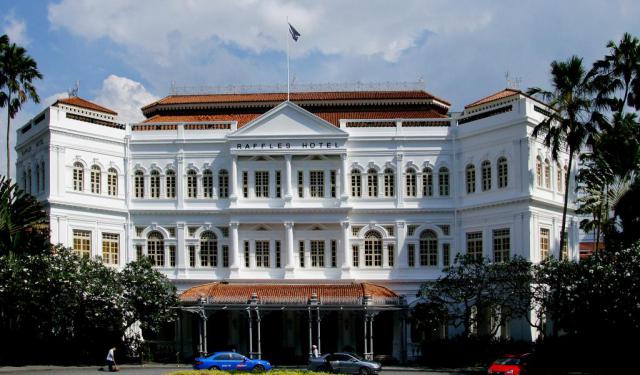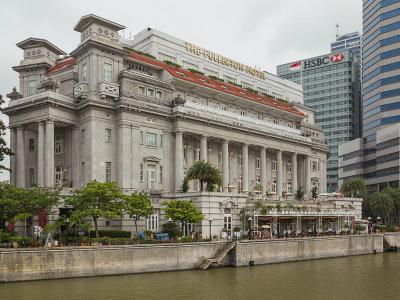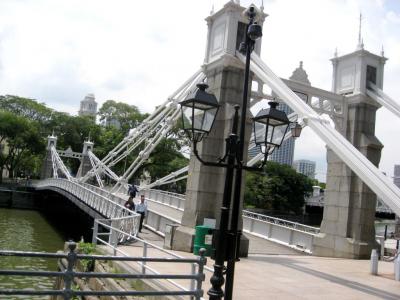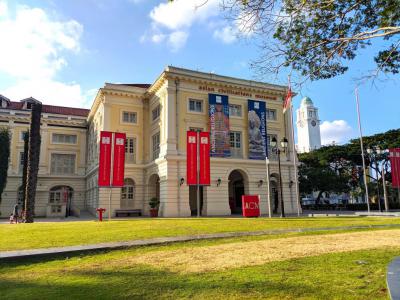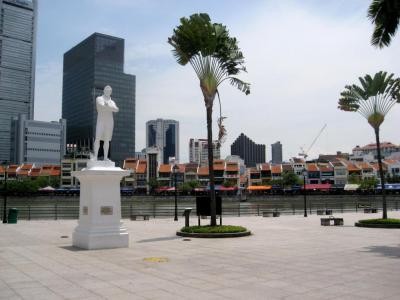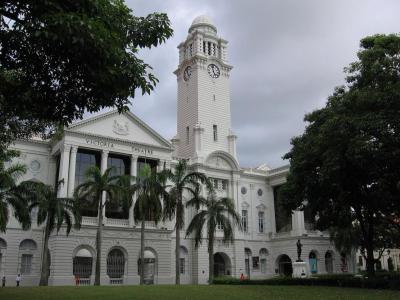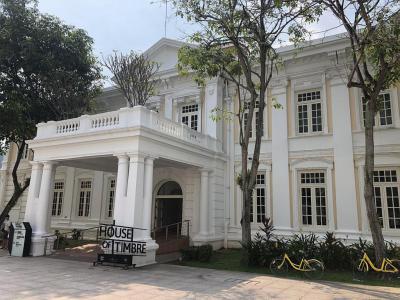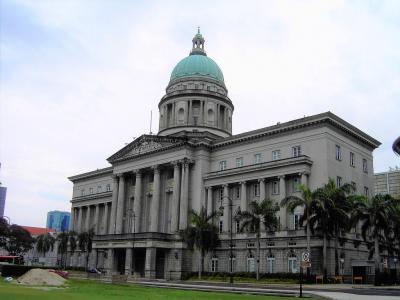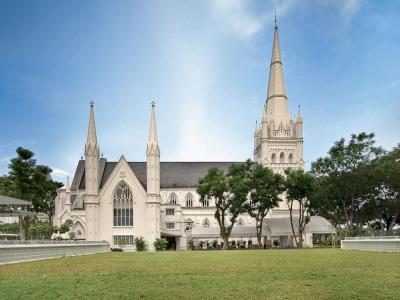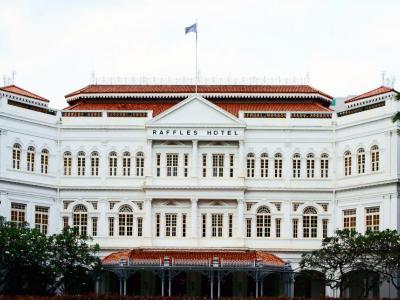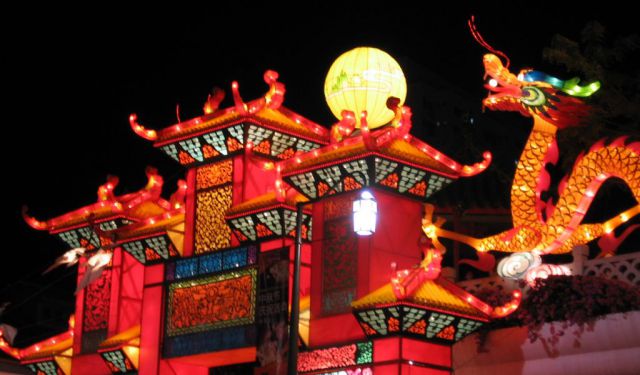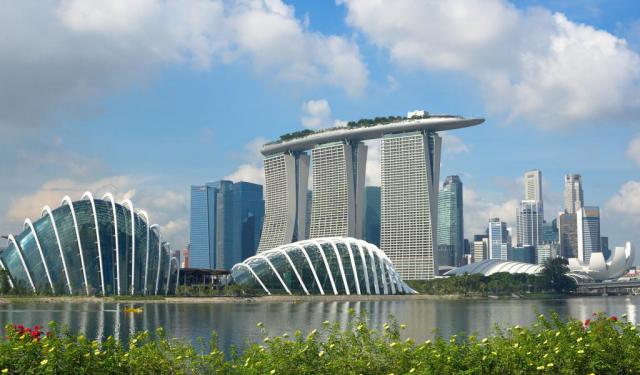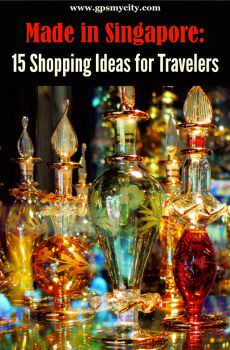Audio Guide: Colonial District Walking Tour (Self Guided), Singapore
Singapore’s Colonial District, also known as the Civic District, is the birthplace of modern Singapore. From a quiet island to a thriving global city, its transformation began right here.
The story kicked off in 1819, when Sir Stamford Raffles of the British East India Company established a trading post on the strategically positioned island. Recognizing the importance of the Singapore River for maritime trade, he designated its banks as the administrative and civic heart of the new settlement. Within a few years, his 1822 Town Plan rolled out a structured grid of government offices, commercial streets, and community zones that still guide the flow of the district today.
As the 19th century rolled along, the district quickly grew into the colony’s centre of power. Grand structures such as Government House, St. Andrew’s Cathedral, and the Supreme Court rose in styles popular across the British Empire, from Palladian symmetry to Gothic Revival drama. The Padang emerged as a key ceremonial space, serving as a parade ground and site for public gatherings. With booming trade came banks, clubs, and civic institutions, turning the district into the social and political hub of colonial Singapore.
In the early 20th century, the ambitions grew even taller. The Municipal Building and the Courthouse joined the skyline, signaling confidence and expanding governance. Then World War II swept in, and the district’s story took a sharp turn. Singapore fell to Japanese forces in 1942, and many buildings were put to military use. When the British returned after 1945, they faced a society increasingly determined to govern itself—a momentum that eventually led to self-rule (in 1959), then merger with Malaysia (in 1963), and finally, independence in 1965. Through all this, the district’s architecture kept its grip on public life.
Fast-forward to the restoration era, and those old colonial giants received a second act. The Fullerton Hotel—once the General Post Office—now greets visitors in glorious Neo-classical fashion. Cavenagh Bridge, the cast-iron beauty from the 1860s, still spans the river with Victorian flair. The Asian Civilizations Museum, Victoria Theatre and Concert Hall, the Arts House, and the National Gallery Singapore breathe new cultural energy into historic walls. Add in St. Andrew’s Cathedral, the Raffles’ Landing Site, and the ever-elegant Raffles Hotel, and you have a district rich in landmarks.
Today, the Colonial District feels like Singapore’s open-air memory bank—a place where the city’s layered past stands side by side with its modern identity, inviting visitors to walk through two centuries of change in the space of a few scenic blocks.
The story kicked off in 1819, when Sir Stamford Raffles of the British East India Company established a trading post on the strategically positioned island. Recognizing the importance of the Singapore River for maritime trade, he designated its banks as the administrative and civic heart of the new settlement. Within a few years, his 1822 Town Plan rolled out a structured grid of government offices, commercial streets, and community zones that still guide the flow of the district today.
As the 19th century rolled along, the district quickly grew into the colony’s centre of power. Grand structures such as Government House, St. Andrew’s Cathedral, and the Supreme Court rose in styles popular across the British Empire, from Palladian symmetry to Gothic Revival drama. The Padang emerged as a key ceremonial space, serving as a parade ground and site for public gatherings. With booming trade came banks, clubs, and civic institutions, turning the district into the social and political hub of colonial Singapore.
In the early 20th century, the ambitions grew even taller. The Municipal Building and the Courthouse joined the skyline, signaling confidence and expanding governance. Then World War II swept in, and the district’s story took a sharp turn. Singapore fell to Japanese forces in 1942, and many buildings were put to military use. When the British returned after 1945, they faced a society increasingly determined to govern itself—a momentum that eventually led to self-rule (in 1959), then merger with Malaysia (in 1963), and finally, independence in 1965. Through all this, the district’s architecture kept its grip on public life.
Fast-forward to the restoration era, and those old colonial giants received a second act. The Fullerton Hotel—once the General Post Office—now greets visitors in glorious Neo-classical fashion. Cavenagh Bridge, the cast-iron beauty from the 1860s, still spans the river with Victorian flair. The Asian Civilizations Museum, Victoria Theatre and Concert Hall, the Arts House, and the National Gallery Singapore breathe new cultural energy into historic walls. Add in St. Andrew’s Cathedral, the Raffles’ Landing Site, and the ever-elegant Raffles Hotel, and you have a district rich in landmarks.
Today, the Colonial District feels like Singapore’s open-air memory bank—a place where the city’s layered past stands side by side with its modern identity, inviting visitors to walk through two centuries of change in the space of a few scenic blocks.
How it works: Download the app "GPSmyCity: Walks in 1K+ Cities" from Apple App Store or Google Play Store to your mobile phone or tablet. The app turns your mobile device into a personal tour guide and its built-in GPS navigation functions guide you from one tour stop to next. The app works offline, so no data plan is needed when traveling abroad.
Colonial District Walking Tour Map
Guide Name: Colonial District Walking Tour
Guide Location: Singapore » Singapore (See other walking tours in Singapore)
Guide Type: Self-guided Walking Tour (Sightseeing)
# of Attractions: 9
Tour Duration: 1 Hour(s)
Travel Distance: 1.7 Km or 1.1 Miles
Author: vickyc
Sight(s) Featured in This Guide:
Guide Location: Singapore » Singapore (See other walking tours in Singapore)
Guide Type: Self-guided Walking Tour (Sightseeing)
# of Attractions: 9
Tour Duration: 1 Hour(s)
Travel Distance: 1.7 Km or 1.1 Miles
Author: vickyc
Sight(s) Featured in This Guide:
- Fullerton Hotel
- Cavenagh Bridge
- Asian Civilisations Museum
- Raffles' Landing Site
- Victoria Theatre and Concert Hall
- Arts House (The Old Parliament Building)
- National Gallery Singapore
- Saint Andrew's Cathedral
- Raffles Hotel Historical Building
1) Fullerton Hotel
At the mouth of the Singapore River, where the financial district rubs shoulders with the arts scene, the Fullerton Hotel Singapore rises like a very confident reminder that history never really left town. Today it’s a luxury hotel, but it began life as the Fullerton Building—a grand colonial heavyweight named after Robert Fullerton, the first Governor of the Straits Settlements. Back in the day, it housed the General Post Office, the Singapore Club, and several other institutions that signalled British authority with every column and cornice.
When opened on 27 June 1928, it was the largest structure in Singapore, and engineers made full use of the tropical breeze. Four internal air-wells acted as natural coolers long before anyone dreamed of central air-conditioning. And just to make things even more interesting, there was a lighthouse once perched on its roof. Known as the Fullerton Light, it replaced the ageing Fort Canning Light, which had become increasingly useless as the skyline climbed and blocked its beam.
In the late 1990s, the building underwent a major restoration and swapped its bureaucratic past for a more glamorous future. Between 1998 and 2000, the Fullerton was remade into a 400-room heritage hotel, with careful attention paid to keeping its personality intact. The old General Post Office gallery stayed, the monumental entrance portico stayed, and even the original Shanghai plaster panels stayed. As for the lighthouse, it found a second life as the Lighthouse Restaurant—because in modern Singapore, even navigational aids get stylish retirements...
In December 2015, the Fullerton Hotel joined Singapore’s list of National Monuments as number 71, securing its place not just as a beautiful landmark, but as a storyteller in stone—one that has watched the city rise, reinvent, and shine right around it.
When opened on 27 June 1928, it was the largest structure in Singapore, and engineers made full use of the tropical breeze. Four internal air-wells acted as natural coolers long before anyone dreamed of central air-conditioning. And just to make things even more interesting, there was a lighthouse once perched on its roof. Known as the Fullerton Light, it replaced the ageing Fort Canning Light, which had become increasingly useless as the skyline climbed and blocked its beam.
In the late 1990s, the building underwent a major restoration and swapped its bureaucratic past for a more glamorous future. Between 1998 and 2000, the Fullerton was remade into a 400-room heritage hotel, with careful attention paid to keeping its personality intact. The old General Post Office gallery stayed, the monumental entrance portico stayed, and even the original Shanghai plaster panels stayed. As for the lighthouse, it found a second life as the Lighthouse Restaurant—because in modern Singapore, even navigational aids get stylish retirements...
In December 2015, the Fullerton Hotel joined Singapore’s list of National Monuments as number 71, securing its place not just as a beautiful landmark, but as a storyteller in stone—one that has watched the city rise, reinvent, and shine right around it.
2) Cavenagh Bridge
Stretching across the Singapore River with a neat little swagger, Cavenagh Bridge links Empress Place to the stately Fullerton Building—now a luxury hotel with more stories than its guests. Built in 1869, it holds the proud title of the only bridge in Singapore that still stands in its original form. In other words, it has survived progress, fashion changes, tropical storms, and the occasional tourist stampede far better than most things its age.
Back in the day, it debuted as Edinburgh Bridge, a polite nod to the visiting Duke of Edinburgh. Later, it took on the name of Major General William Cavenagh, the last India-appointed Governor of the Straits Settlements—probably because “Cavenagh Bridge” rolls off the tongue far better than “Let’s-meet-at-the-bridge-named-after-a-royal-visit.” Crafted in Glasgow, shipped in pieces, and assembled on-site by Indian convict labourers, the bridge was almost demolished in 1910 after the nearby Anderson Bridge opened. Luckily, practicality won the day, and Cavenagh was turned into a footbridge instead. Today, it still welcomes walkers—as long as each one stays under 152 kilograms, a detail the bridge announces with the confidence of an old aunt reminding you not to overload her good china.
Indeed, as a charming slice of Singapore’s past, this bridge offers great river views and a few quirky surprises. Near the Fullerton side, an undeniably cute bronze cat and her kittens lounge as if they own both banks of the river—which, in true cat fashion, they probably believe they do. On the opposite end, bronze children leap joyfully into the water, capturing a nostalgia so strong you may briefly consider joining them (before remembering the river is not exactly a swimming pool)...
Tip: If you’re collecting photo memories, wander to the south bank for more sculptures showing scenes from old Singapore. It’s like walking through a living postcard—minus the need for stamps...
Back in the day, it debuted as Edinburgh Bridge, a polite nod to the visiting Duke of Edinburgh. Later, it took on the name of Major General William Cavenagh, the last India-appointed Governor of the Straits Settlements—probably because “Cavenagh Bridge” rolls off the tongue far better than “Let’s-meet-at-the-bridge-named-after-a-royal-visit.” Crafted in Glasgow, shipped in pieces, and assembled on-site by Indian convict labourers, the bridge was almost demolished in 1910 after the nearby Anderson Bridge opened. Luckily, practicality won the day, and Cavenagh was turned into a footbridge instead. Today, it still welcomes walkers—as long as each one stays under 152 kilograms, a detail the bridge announces with the confidence of an old aunt reminding you not to overload her good china.
Indeed, as a charming slice of Singapore’s past, this bridge offers great river views and a few quirky surprises. Near the Fullerton side, an undeniably cute bronze cat and her kittens lounge as if they own both banks of the river—which, in true cat fashion, they probably believe they do. On the opposite end, bronze children leap joyfully into the water, capturing a nostalgia so strong you may briefly consider joining them (before remembering the river is not exactly a swimming pool)...
Tip: If you’re collecting photo memories, wander to the south bank for more sculptures showing scenes from old Singapore. It’s like walking through a living postcard—minus the need for stamps...
3) Asian Civilisations Museum
With the resemblance of a grand old neighbour watching the city, the former Empress Place Building has been in place—at the mouth of the Singapore River—since 1867. It’s the kind of structure that looks like it was sketched with a ruler in one hand and a fan in the other—perfectly balanced, elegantly decorated, and proudly Neoclassical. The Palladian exterior still shows off its original Roman Doric façade, pitched clay roofs, and long arcaded verandahs. Add in those timber-louvered French windows—Singapore’s early, natural version of “air-conditioning”—, and you can imagine how many migrants arriving by boat must have stared up at it, thinking, “So, this is Singapore...”
Today, the building has swapped colonial administration for cultural exploration as the home of the Asian Civilisations Museum. Its mission is to connect the dots between Asian cultures—from the Middle East to China—and show how their stories blend into Singapore’s multicultural identity. It’s a tall order, but the museum pulls it off with confidence.
Inside, the galleries shine in more ways than one. The Hindu-Buddhist section glows with beautifully lit displays, including an impressive 18th-century Burmese Buddha head and a massive bronze drum. The Chinese galleries are equally rich, especially the collection of ceramics recovered from a 1998 shipwreck—over 60,000 pieces in total, some dating back to the Tang dynasty. In the Malay World section, keep an eye out for the Kelantan Makara, a wide-eyed mythical creature that once starred in ritual ceremonies. And scattered throughout the museum are striking examples of textiles, lacquerware, porcelain, costumes, and towering processional figures.
When you’re ready for a break, the building has you covered. “Empress” restaurant offers Chinese cuisine with waterfront views, while “Privé ACM” cafe lets you unwind alfresco-style beside the river, with Singapore’s business district rising in the background. The museum shop is also worth a browse, with books and souvenirs that match the quality of the exhibits.
If you want a deeper dive, free English tours are offered daily, usually at 11:30 am, 1:30 pm, and 3 pm. And for anyone planning to explore more local museums, a multi-museum pass is a smart way to make the most of your visit.
Today, the building has swapped colonial administration for cultural exploration as the home of the Asian Civilisations Museum. Its mission is to connect the dots between Asian cultures—from the Middle East to China—and show how their stories blend into Singapore’s multicultural identity. It’s a tall order, but the museum pulls it off with confidence.
Inside, the galleries shine in more ways than one. The Hindu-Buddhist section glows with beautifully lit displays, including an impressive 18th-century Burmese Buddha head and a massive bronze drum. The Chinese galleries are equally rich, especially the collection of ceramics recovered from a 1998 shipwreck—over 60,000 pieces in total, some dating back to the Tang dynasty. In the Malay World section, keep an eye out for the Kelantan Makara, a wide-eyed mythical creature that once starred in ritual ceremonies. And scattered throughout the museum are striking examples of textiles, lacquerware, porcelain, costumes, and towering processional figures.
When you’re ready for a break, the building has you covered. “Empress” restaurant offers Chinese cuisine with waterfront views, while “Privé ACM” cafe lets you unwind alfresco-style beside the river, with Singapore’s business district rising in the background. The museum shop is also worth a browse, with books and souvenirs that match the quality of the exhibits.
If you want a deeper dive, free English tours are offered daily, usually at 11:30 am, 1:30 pm, and 3 pm. And for anyone planning to explore more local museums, a multi-museum pass is a smart way to make the most of your visit.
4) Raffles' Landing Site
The bronze statue of Sir Stamford Raffles, standing confidently by the Singapore River, claims to mark the exact spot where Singapore's founder supposedly first stepped ashore on 29 January 1819. In his day, this wasn’t the polished Civic District packed with galleries and government buildings—it was swamp, mud, and the occasional tiger who probably wasn’t thrilled about uninvited guests.
For someone who barely stayed long enough to unpack (his longest stint in Singapore lasted only eight months), Raffles left fingerprints all over the city. His name pops up everywhere, but his influence goes deeper than commemorative plaques. Much of the street grid in central Singapore still follows his original plan. The ethnic quarters, including Little India, were parceled out under his watch. Even the classic shop-house design, with its brick frame and handy central courtyard, is often credited to him. In short, Singapore’s rise as a world-class seaport traces right back to Raffles’ rather bold ideas.
And bold they were. Sizing up the island as the perfect counterweight to Dutch power, Raffles moved fast. He negotiated with Abdul Rahman, the local chieftain, to establish a British trading post. But knowing the reigning sultan leaned a little too close to Dutch interests for comfort, Raffles took a diplomatic detour. He approached the sultan’s elder brother, Hussein—politely addressing him as His Highness the Sultan—and formed a second treaty with both him and Abdul Rahman. With that, the Union Jack went up, and Singapore’s future as a British stronghold was sealed.
From there, the island took off. Its duty-free status and prime location at the gateway to the South China Sea drew migrants from China, India, and Europe, all chasing opportunity. By 1860, the population had hit 80,000. By the late 19th century—helped along by the opening of the Suez Canal and the arrival of steamships—Singapore had secured its role as the region’s powerhouse port.
Today, as Raffles gazes over a district that looks nothing like the swamp he once walked into, his statue stands as a reminder that even a short visit can change the course of history—though it certainly helps to have a grand plan and impeccable timing...
For someone who barely stayed long enough to unpack (his longest stint in Singapore lasted only eight months), Raffles left fingerprints all over the city. His name pops up everywhere, but his influence goes deeper than commemorative plaques. Much of the street grid in central Singapore still follows his original plan. The ethnic quarters, including Little India, were parceled out under his watch. Even the classic shop-house design, with its brick frame and handy central courtyard, is often credited to him. In short, Singapore’s rise as a world-class seaport traces right back to Raffles’ rather bold ideas.
And bold they were. Sizing up the island as the perfect counterweight to Dutch power, Raffles moved fast. He negotiated with Abdul Rahman, the local chieftain, to establish a British trading post. But knowing the reigning sultan leaned a little too close to Dutch interests for comfort, Raffles took a diplomatic detour. He approached the sultan’s elder brother, Hussein—politely addressing him as His Highness the Sultan—and formed a second treaty with both him and Abdul Rahman. With that, the Union Jack went up, and Singapore’s future as a British stronghold was sealed.
From there, the island took off. Its duty-free status and prime location at the gateway to the South China Sea drew migrants from China, India, and Europe, all chasing opportunity. By 1860, the population had hit 80,000. By the late 19th century—helped along by the opening of the Suez Canal and the arrival of steamships—Singapore had secured its role as the region’s powerhouse port.
Today, as Raffles gazes over a district that looks nothing like the swamp he once walked into, his statue stands as a reminder that even a short visit can change the course of history—though it certainly helps to have a grand plan and impeccable timing...
5) Victoria Theatre and Concert Hall
Roll your shoulders back and look up: the Victoria Theatre and Concert Hall isn’t just one building—it’s a well-dressed duo linked by a corridor and anchored by a proud clock tower keeping everyone on schedule. Sitting right in Singapore’s Civic District, this elegant pair has seen more drama, politics, and history than most theatres ever host onstage.
In 1919, when Singapore celebrated its 100th birthday, the complex gained a new front-of-house star. The statue of Stamford Raffles—carved by sculptor T. Woolner—was ceremoniously moved from the Padang to the entrance of the memorial hall. To make the founder feel more at home, the city added a semi-circular colonnade and a reflecting pool, creating a sort of early 20th-century VIP lounge.
Everything changed during World War II. The memorial hall was hastily converted into a hospital during the Japanese air raids, treating victims of the Battle of Singapore. The buildings themselves survived the occupation with surprisingly few wounds, though the colonnade didn’t make it, and Raffles was once again packed up and moved—this time to the National Museum. After the war, the hall shifted roles yet again, becoming the setting for Japanese war crimes trials, a somber chapter in an already eventful history.
By 1954, Singapore was reinventing itself, and so was the complex. Architecture firm Swan & Maclaren gave the memorial hall a makeover, just in time for it to host a political debut: the founding of the People’s Action Party on November 21. The town hall’s interior was reworked to welcome air-conditioning and soundproofing—modern luxuries that paved the way for its transformation into the Victoria Theatre.
Then came 1979, when the memorial hall prepared for its most melodic role yet. Refitted to become the home of the Singapore Symphony Orchestra, it emerged from renovation with a new identity as the Victoria Concert Hall.
Today, the complex stands as a polished blend of civic memory, architectural grace, and cultural rhythm—proof that even buildings can lead interesting lives with multiple acts, costume changes, and standing ovations...
In 1919, when Singapore celebrated its 100th birthday, the complex gained a new front-of-house star. The statue of Stamford Raffles—carved by sculptor T. Woolner—was ceremoniously moved from the Padang to the entrance of the memorial hall. To make the founder feel more at home, the city added a semi-circular colonnade and a reflecting pool, creating a sort of early 20th-century VIP lounge.
Everything changed during World War II. The memorial hall was hastily converted into a hospital during the Japanese air raids, treating victims of the Battle of Singapore. The buildings themselves survived the occupation with surprisingly few wounds, though the colonnade didn’t make it, and Raffles was once again packed up and moved—this time to the National Museum. After the war, the hall shifted roles yet again, becoming the setting for Japanese war crimes trials, a somber chapter in an already eventful history.
By 1954, Singapore was reinventing itself, and so was the complex. Architecture firm Swan & Maclaren gave the memorial hall a makeover, just in time for it to host a political debut: the founding of the People’s Action Party on November 21. The town hall’s interior was reworked to welcome air-conditioning and soundproofing—modern luxuries that paved the way for its transformation into the Victoria Theatre.
Then came 1979, when the memorial hall prepared for its most melodic role yet. Refitted to become the home of the Singapore Symphony Orchestra, it emerged from renovation with a new identity as the Victoria Concert Hall.
Today, the complex stands as a polished blend of civic memory, architectural grace, and cultural rhythm—proof that even buildings can lead interesting lives with multiple acts, costume changes, and standing ovations...
6) Arts House (The Old Parliament Building)
Just a few steps from where Raffles supposedly first planted his boots on Singapore soil sits the Arts House, better known in its earlier life as the Old Parliament House. These days it’s a lively arts venue hosting exhibitions, concerts, and the occasional experimental performance—but beneath all that creative energy lies a building with nearly two centuries of political mileage. Constructed in 1827, it claims the title of Singapore’s oldest surviving government building, and quite possibly the oldest surviving building in the entire city. From 1965 until 1999, this was the seat of Singapore’s Parliament, before the politicians upgraded to their newer lodgings next door.
The structure owes its existence to architect George Drumgoole Coleman, who designed it as a neat Neo-Palladian mansion for private use. That plan didn’t last long. The building was quickly absorbed into public service and cycled through a string of official roles: courthouse, Land Office, and general administrative headquarters for a young colony with big ambitions. In 1839, a single-storey annex appeared on the plot behind it—today recognised as the Former Attorney-General’s Chambers—and eventually folded into the Parliament complex.
As time marched on, so did the renovations. Major extensions in the 1870s and again in 1901 pushed the building outward toward the Singapore River, gradually erasing Coleman’s original lines. In 1909, two courtrooms were rebuilt, and a residence for the Attorney-General was added, nudging the architectural style toward a more Victorian look. Another major update came in the 1950s to prepare the place for the newly formed Legislative Assembly.
Then came its big reinvention. On 26 March 2004, the building stepped out of its political career and into a new role as a heritage centre for writers, artists, and anyone with a creative spark. Restored with care—from the Tuscan-style columns to the crisp cornices—it now stages festivals, performances, and programs that celebrate Singaporean imagination.
The place's interactive gallery offers a breezy, enjoyable dive into Singapore’s artistic landscape and its development over the last five decades. And yes, snapping a selfie in the seat of Singapore’s first Prime Minister is absolutely allowed.
Bonus tip: It’s usually open, free, and surprisingly quiet during the day. In other words, you might just get an entire historic Parliament House to yourself… plus one mildly amused security guard.
The structure owes its existence to architect George Drumgoole Coleman, who designed it as a neat Neo-Palladian mansion for private use. That plan didn’t last long. The building was quickly absorbed into public service and cycled through a string of official roles: courthouse, Land Office, and general administrative headquarters for a young colony with big ambitions. In 1839, a single-storey annex appeared on the plot behind it—today recognised as the Former Attorney-General’s Chambers—and eventually folded into the Parliament complex.
As time marched on, so did the renovations. Major extensions in the 1870s and again in 1901 pushed the building outward toward the Singapore River, gradually erasing Coleman’s original lines. In 1909, two courtrooms were rebuilt, and a residence for the Attorney-General was added, nudging the architectural style toward a more Victorian look. Another major update came in the 1950s to prepare the place for the newly formed Legislative Assembly.
Then came its big reinvention. On 26 March 2004, the building stepped out of its political career and into a new role as a heritage centre for writers, artists, and anyone with a creative spark. Restored with care—from the Tuscan-style columns to the crisp cornices—it now stages festivals, performances, and programs that celebrate Singaporean imagination.
The place's interactive gallery offers a breezy, enjoyable dive into Singapore’s artistic landscape and its development over the last five decades. And yes, snapping a selfie in the seat of Singapore’s first Prime Minister is absolutely allowed.
Bonus tip: It’s usually open, free, and surprisingly quiet during the day. In other words, you might just get an entire historic Parliament House to yourself… plus one mildly amused security guard.
7) National Gallery Singapore
It won't be an exaggeration to call the National Gallery Singapore the city’s grand backstage pass to Southeast Asian art—except this backstage spans two colossal national monuments and holds more than 8,000 artworks. Indeed, this is the world’s largest public collection of art from Singapore and the region, and its mission is simple enough: help visitors understand how Singapore’s artistic story connects with its neighbours and, eventually, the wider world.
The gallery lives inside the former Supreme Court and City Hall buildings, two historic giants that together cover about 64,000 square metres of floor space. With that much room to play with, it naturally became Singapore’s most expansive museum and its biggest visual arts venue—essentially a small city dedicated entirely to creativity.
Inside, the focus lands squarely on modern and contemporary art from the 19th century onward. Two permanent galleries anchor this narrative: the DBS Singapore Gallery and the UOB Southeast Asia Gallery. Together, they walk listeners through shifting cultural identities, political changes, and the many artistic experiments that emerged across the region.
At the heart of it all is Singapore’s National Collection, the world’s largest public assembly of modern and contemporary Southeast Asian art. It began modestly in 1976 with just 93 donated works from Malaysian business magnate, Dato Loke Wan Tho. By 2010, the collection had grown to roughly 8,000 pieces, now under the care of the National Heritage Board. As such, it forms the backbone of the gallery’s exhibitions and research.
Here, you'll also meet some of Singapore’s most influential artists along the way. Names like Georgette Chen, Chen Chong Swee, Chen Wen Hsi, Cheong Soo Pieng, and Liu Kang appear throughout the galleries, represented in everything from early ink paintings to bold canvases and contemporary video works. Their art charts the evolution of Singapore’s creative identity throughout the decades, offering a vivid introduction to the country’s cultural imagination.
The gallery lives inside the former Supreme Court and City Hall buildings, two historic giants that together cover about 64,000 square metres of floor space. With that much room to play with, it naturally became Singapore’s most expansive museum and its biggest visual arts venue—essentially a small city dedicated entirely to creativity.
Inside, the focus lands squarely on modern and contemporary art from the 19th century onward. Two permanent galleries anchor this narrative: the DBS Singapore Gallery and the UOB Southeast Asia Gallery. Together, they walk listeners through shifting cultural identities, political changes, and the many artistic experiments that emerged across the region.
At the heart of it all is Singapore’s National Collection, the world’s largest public assembly of modern and contemporary Southeast Asian art. It began modestly in 1976 with just 93 donated works from Malaysian business magnate, Dato Loke Wan Tho. By 2010, the collection had grown to roughly 8,000 pieces, now under the care of the National Heritage Board. As such, it forms the backbone of the gallery’s exhibitions and research.
Here, you'll also meet some of Singapore’s most influential artists along the way. Names like Georgette Chen, Chen Chong Swee, Chen Wen Hsi, Cheong Soo Pieng, and Liu Kang appear throughout the galleries, represented in everything from early ink paintings to bold canvases and contemporary video works. Their art charts the evolution of Singapore’s creative identity throughout the decades, offering a vivid introduction to the country’s cultural imagination.
8) Saint Andrew's Cathedral
If you’re looking for a building that has survived drama, reinvention, and a couple of near-electrocutions, Saint Andrew’s Cathedral is more than ready for its close-up. Today, it’s Singapore’s largest Anglican church and a striking Neo-Gothic landmark, instantly recognizable by its gleaming Madras chunam exterior—a kind of 19th-century “photo filter” made from polished lime and egg white that gave colonial buildings their trademark shine.
Back in 1822, Sir Stamford Raffles earmarked this patch of land for an Anglican church. Funds took their time arriving, so construction only got going in 1835.
The first version, designed by George Drumgoole Coleman, leaned heavily toward Neo-Classical elegance. So elegant, in fact, that critics accused it of looking suspiciously like a town hall—or perhaps a college that had lost its way. A spire was added in 1842 to make it feel more “churchy,” but it came without a lightning conductor. The result was two direct lightning hits in four years, after which the building was politely retired from service and demolished.
As a sequel, Governor William Butterworth commissioned a new church, this time placing the project in the hands of Colonel Ronald MacPherson. The latter took inspiration from the atmospheric ruins of Netley Abbey in Hampshire, England, producing a Gothic Revival cathedral with soaring arches and nave piers that feel like distant cousins of those medieval originals.
Step toward the apse and you’ll spot three stained-glass windows honouring key figures in Singapore's colonial history, namely: Sir Stamford Raffles in the centre, John Crawfurd on the left, and General William Butterworth on the right. The cathedral’s links to the wider Anglican world appear in its treasured artifacts—the Canterbury Stone, the Coventry Cross fashioned from salvaged cathedral nails, and even a piece of the coronation carpet used when Queen Elizabeth II was crowned.
During the Japanese occupation, the cathedral transformed into an emergency hospital, and its role in Singapore’s wartime story only deepened its symbolic weight. In 1973, the building received National Monument status—an official nod to its resilience, its architectural charm, and its ability to survive lightning, war, and the occasional design critique...
Back in 1822, Sir Stamford Raffles earmarked this patch of land for an Anglican church. Funds took their time arriving, so construction only got going in 1835.
The first version, designed by George Drumgoole Coleman, leaned heavily toward Neo-Classical elegance. So elegant, in fact, that critics accused it of looking suspiciously like a town hall—or perhaps a college that had lost its way. A spire was added in 1842 to make it feel more “churchy,” but it came without a lightning conductor. The result was two direct lightning hits in four years, after which the building was politely retired from service and demolished.
As a sequel, Governor William Butterworth commissioned a new church, this time placing the project in the hands of Colonel Ronald MacPherson. The latter took inspiration from the atmospheric ruins of Netley Abbey in Hampshire, England, producing a Gothic Revival cathedral with soaring arches and nave piers that feel like distant cousins of those medieval originals.
Step toward the apse and you’ll spot three stained-glass windows honouring key figures in Singapore's colonial history, namely: Sir Stamford Raffles in the centre, John Crawfurd on the left, and General William Butterworth on the right. The cathedral’s links to the wider Anglican world appear in its treasured artifacts—the Canterbury Stone, the Coventry Cross fashioned from salvaged cathedral nails, and even a piece of the coronation carpet used when Queen Elizabeth II was crowned.
During the Japanese occupation, the cathedral transformed into an emergency hospital, and its role in Singapore’s wartime story only deepened its symbolic weight. In 1973, the building received National Monument status—an official nod to its resilience, its architectural charm, and its ability to survive lightning, war, and the occasional design critique...
9) Raffles Hotel Historical Building
Undoubtedly, the Raffles Hotel is Singapore’s most elegant time machine—one with polished teak floors, snow-white facades, and a guestbook that reads like a century-long celebrity roll call. Founded on December 1, 1887, by the ambitious Sarkies Brothers—Armenian hoteliers with a flair for grandeur—it was named after Sir Stamford Raffles, the man who set Singapore’s early foundations. A hundred years later, in 1987, the hotel was officially declared a National Monument, cementing its place in the city’s story.
Over the decades, everyone from Charlie Chaplin and Somerset Maugham to Elizabeth Taylor and Karl Lagerfeld passed through its doors. The hotel even earned a quirky footnote in local history as the place where Singapore’s last tiger was shot—an event that leaves visitors blinking twice whenever they hear it. And of course, the Long Bar still claims fame as the birthplace of the iconic Singapore Sling cocktail, where the clink of glasses continues a tradition over a century old.
Early on, Raffles Hotel introduced luxuries the tropics had never seen: powered ceiling fans, electric lights, and enough modern comforts to make travellers forget they were half a world away from home. New wings, grand verandas, a ballroom, a bar, and a billiards room soon followed. Then came February 1942: as Japanese forces entered Singapore, the hotel’s guests danced a final waltz while staff quietly buried silver—including the famous beef trolley—in the Palm Court. Renamed Syonan Ryokan during the occupation, the hotel returned to British hands in 1945.
Two major restorations—in 1989 and again in 2017—polished the building back to its 1915 splendour while adding the realities of modern travel. Every room became a suite, soundproofing improved, technology was discreetly woven in, and new suites expanded the hotel’s layout. The Long Bar shifted to the nearby shopping arcade, the Writer’s Bar gained its own intimate corner, and the old Jubilee Theatre transformed into a gleaming ballroom.
Today, the Raffles Hotel shopping arcade offers about 40 boutique stores alongside most of its dining venues. Step outside those elegant corridors and you’ll find a tropical garden softening every edge—one last reminder that this legendary hotel is both a relic of the past and one of Singapore’s most charming places to pause...
Over the decades, everyone from Charlie Chaplin and Somerset Maugham to Elizabeth Taylor and Karl Lagerfeld passed through its doors. The hotel even earned a quirky footnote in local history as the place where Singapore’s last tiger was shot—an event that leaves visitors blinking twice whenever they hear it. And of course, the Long Bar still claims fame as the birthplace of the iconic Singapore Sling cocktail, where the clink of glasses continues a tradition over a century old.
Early on, Raffles Hotel introduced luxuries the tropics had never seen: powered ceiling fans, electric lights, and enough modern comforts to make travellers forget they were half a world away from home. New wings, grand verandas, a ballroom, a bar, and a billiards room soon followed. Then came February 1942: as Japanese forces entered Singapore, the hotel’s guests danced a final waltz while staff quietly buried silver—including the famous beef trolley—in the Palm Court. Renamed Syonan Ryokan during the occupation, the hotel returned to British hands in 1945.
Two major restorations—in 1989 and again in 2017—polished the building back to its 1915 splendour while adding the realities of modern travel. Every room became a suite, soundproofing improved, technology was discreetly woven in, and new suites expanded the hotel’s layout. The Long Bar shifted to the nearby shopping arcade, the Writer’s Bar gained its own intimate corner, and the old Jubilee Theatre transformed into a gleaming ballroom.
Today, the Raffles Hotel shopping arcade offers about 40 boutique stores alongside most of its dining venues. Step outside those elegant corridors and you’ll find a tropical garden softening every edge—one last reminder that this legendary hotel is both a relic of the past and one of Singapore’s most charming places to pause...
Walking Tours in Singapore, Singapore
Create Your Own Walk in Singapore
Creating your own self-guided walk in Singapore is easy and fun. Choose the city attractions that you want to see and a walk route map will be created just for you. You can even set your hotel as the start point of the walk.
Chinatown Walking Tour
Chinatown is one of Singapore’s most culturally layered districts, shaped over two centuries by the Chinese community, which today makes up the majority of the local population. Here, history, heritage, and the irresistible smell of good food all try to grab your attention at once.
The story began in 1819, when Stamford Raffles set up Singapore as a trading post and drew up a town plan that... view more
Tour Duration: 1 Hour(s)
Travel Distance: 1.4 Km or 0.9 Miles
The story began in 1819, when Stamford Raffles set up Singapore as a trading post and drew up a town plan that... view more
Tour Duration: 1 Hour(s)
Travel Distance: 1.4 Km or 0.9 Miles
Singapore Introduction Walking Tour
Singapore may well be a tiny nation, sitting on a patch of land in Southeast Asia, but it has mastered the art of making a grand impression. Here, centuries-old temples share the skyline with futuristic glass towers, and you can walk from a quiet shrine to a neon-lit mall in the time it takes to finish an iced coffee. The city’s multicultural spirit—shaped by Chinese, Malay, and Indian... view more
Tour Duration: 2 Hour(s)
Travel Distance: 3.6 Km or 2.2 Miles
Tour Duration: 2 Hour(s)
Travel Distance: 3.6 Km or 2.2 Miles
Useful Travel Guides for Planning Your Trip
12 Singapore Foods You Should Not Miss
Food is a national passion for Singaporeans. Locals think and talk about food incessantly, often thinking nothing of travelling for miles across the island and queuing for hours just to taste one of their favourite dishes.
Singaporeans abroad will bemoan being parted from their favourite foods,...
Traveler's Guide to Singapore: 15 Souvenirs to Bring Home
Known as one of the Four Asian Tigers (or Dragons), Singapore is a thriving metropolis and one of the most fascinating tourist destinations in Asia. Home to multi-ethnic community, the city carefully preserves and proudly exhibits its colorful identity, manifested - among other forms - in the...
The Most Popular Cities
/ view all
